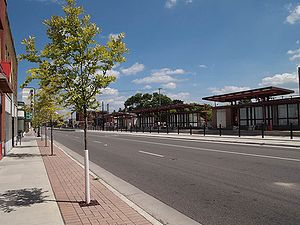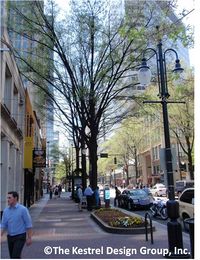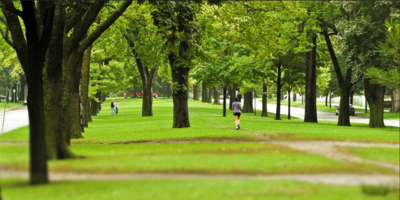
Difference between revisions of "Green Infrastructure benefits of tree trenches and tree boxes"
m |
m |
||
| Line 20: | Line 20: | ||
| Air quality || <font size=4><center>◕</center></font size> || | | Air quality || <font size=4><center>◕</center></font size> || | ||
|- | |- | ||
| − | | Habitat improvement || <font size= | + | | Habitat improvement || <font size=4><center>◕</center></font size> || Use of perennial vegetation and certain media mixes promote invertebrate communities. |
|- | |- | ||
| Community livability || <font size=6><center>●</center></font size> || Aesthetically pleasing and can be incorporated into a wide range of land use settings. | | Community livability || <font size=6><center>●</center></font size> || Aesthetically pleasing and can be incorporated into a wide range of land use settings. | ||
Revision as of 13:52, 20 November 2019
This page is in development

Tree trenches and tree boxes are vegetated engineered landscape practices designed to filter or infiltrate stormwater runoff. They can be incorporated into a wide variety of landscaped areas, including ultra-urban landscapes. Technically, tree boxes and tree trenches are bioretention practices, but their design, construction, maintenance, and benefits merit a separate discussion. Note that this page does not discuss urban forests and use of trees in natural landscape settings. These are discussed on a separate page.
Contents
Green Infrastructure benefits of tree trenches and tree boxes
| Benefit | Effectiveness | Notes |
|---|---|---|
| Water quality | Benefits are maximized for bioinfiltration. Biofiltration may export phosphorus if not designed properly. | |
| Water quantity/supply | Bioinfiltration helps mimic natural hydrology. Some rate control benefit. | |
| Energy savings | ||
| Climate resiliency | Provides some rate control. Impacts on carbon sequestration are uncertain. | |
| Air quality | ||
| Habitat improvement | Use of perennial vegetation and certain media mixes promote invertebrate communities. | |
| Community livability | Aesthetically pleasing and can be incorporated into a wide range of land use settings. | |
| Health benefits | ||
| Economic savings | Generally provide cost savings vs. conventional practices over the life of the practice. | |
| Macroscale benefits | Individual practices are typically microscale, but multiple practices, when incorporated into a landscape design, provide macroscale benefits such as wildlife corridors. | |
| Level of benefit: ◯ - none; ◔; - small; ◑ - moderate; ◕ - large; ● - very high | ||
Because of their diversity and use of vegetation, tree trench and tree box practices provide multiple green infrastructure benefits.
- Water quality: Tree trenches and tree boxes are an excellent stormwater treatment practice due to the variety of pollutant removal mechanisms including vegetative filtering, settling, evaporation, infiltration, transpiration, biological and microbiological uptake, and soil adsorption. Tree trenches and tree boxes can be designed as an effective infiltration / recharge practice, particularly when parent soils have high permeability (> ~ 0.5 inches per hour). Link to water quality information for tree trench/tree box - [1]
- Water quantity/supply: Tree trenches and tree boxes can be designed as an effective infiltration / recharge practice when parent soils have high permeability. Large tree trench systems can be incorporated into ultra-urban settings and provide significant volume control. For lower permeability soils an underdrain is typically used and some infiltration and rate control can be achieved.
- Climate resiliency: Properly installed and maintained trees provide significant benefits for climate resiliency. The primary benefit is through carbon sequestration. A mature tree typically sequesters about 50 pounds of carbon per year, depending on species, tree health, and tree growth rate (U.S. Department of Energy, Energy Information Administration, 1998). Nowak and Crane (2002) estimated that urban forests store about 700 million tonnes of carbon. Although carbon storage per unit area was only about half that in forested areas, urban forests grow quickly and trees reach maturity sooner compared to natural forests.
- Habitat improvement:

Design considerations
Tree trenches and tree boxes are bioretention practices. Therefore, design considerations to enhance green infrastructure benefits of tree trenches and tree boxes are similar to design recommendations for bioretention.
Maximizing specific green infrastructure (GI) benefits requires design considerations prior to constructing the practice. While site limitations cannot always be overcome, the following recommendations maximize the GI benefit of bioretetnion.
- Water quality
- Maximize infiltration by designing with the maximum ponded depth that can be infiltrated in 48 hours, up to 1.5 feet (to protect vegetation). Where space allows, surface area can also be increased. Utilize multiple bioretention practices in series. On lower permeability soils where an underdrain is used, raise the underdrain to the maximum extent possible, allowing water stored in the bioretention media below the underdrain to drain in 48 hours. Use an upturned elbow in underdrained systems.
- For bioinfiltration (bioretention without an underdrain), use a high organic matter media to maximize pollutant removal
- For biofiltration (bioretention with an underdrain), use a media mix that does not export phosphorus or use an amendment to attenuate phosphorus.
- Water quantity/supply
- Maximize infiltration
- Utilize internal water storage
- Maximize water storage in media
- Climate resiliency
- Select species that are more likely to survive in the anticipated future climate
- Select species that efficiently sequester carbon
- Ensure trees receive adequate water
- To reduce heat island effects, select vegetation that reflects solar energy, absorbs solar energy and releases it slowly, or that maximizes evapotranspiration NYC Mayor’s Office of Recovery and Resiliency
- Oversize storage area to account for increased precipitation. Winston (2016) recommends oversizing by 33-45% for bioretention in northern Ohio. Oversizing can also be accomplished by reducing loading to individual bioretention practices. ([2], [3], [4], [5], [6], [7])
- Habitat
- Utilize native, perennial vegetation, including shrubs and trees if space allows. For more information, see Minnesota plant lists.
- Incorporate landscape features, such as form, plant layering, and plant density. For more information on landscape factors, see this presentation by Dr. Steven Rodie (University of Nebraska at Omaha)
- Maximize leaf/plant litter depth and the number of plant taxa
- Consider shape and size to create larger interior habitats
- Evaluate adjacent plant communities for compatibility with proposed bioretention area species. Identify nearby vegetated areas that are dominated by nonnative invasive species.
- Promote soil (media) that maximizes habitat for invertebrate. This includes adjusting pH, limiting the amount of gravel, and promoting development of organic matter. See Kazemi et al. (2009) for more information.
- Community livability
- Choose locations for bioretention that enhance aesthetics
- Choose vegetation that mimics a native landscape, such as tall grass prairie or mixed woodland.
- Evaluate the best placement of vegetation within the bioretention area. Place plants at irregular intervals to replicate a natural setting. Trees should be placed on the perimeter of the area to provide shade and shelter from the wind. Trees and shrubs can be sheltered from damaging flows if they are placed away from the path of the incoming runoff. In cold climates, species that are more tolerant to cold winds, such as evergreens, should be placed in windier areas of the site.
- Health benefits
- Choose locations for bioretention that enhance aesthetics
- Perennial vegetation, particularly shrubs and trees, provide health benefits related to filtering air pollutants. See The Health Benefits of Trees (Hamblin, 2014)
- Economic benefits
- Choose the correct BMP. There is no comprehensive guidance on this, but an important factor in selecting BMPs is cost per unit treatment. This depends on the goal of the project, but examples of costs may be dollars per cubic foot of water treated or per pound of pollutant. Barr Engineering completed a report that provides information on construction costs, maintenance costs, and land requirements for several stormwater BMPs. The report includes references to other useful reports. Information in the report can be used to match the site goals (e.g. infiltration vs. filtration) and site conditions (e.g. large vs. small site) to the most cost-efficient BMP.
- Factor in all benefits in evaluating the economic value of a BMP or multiple GI practices. For example, appropriate implementation of GI practices can enhance property values. Proper selection of vegetation provides energy savings. Utilizing captured rainwater as an indoor non-potable water source provides savings on energy and water use.
- Utilize multiple properly placed BMPs that work together. For example, permeable pavement can be integrated with tree trenches and tree boxes to provide an aesthetically pleasing landscape that increases the value of the property while increasing the efficiency of stormwater treatment.
Tree ordinances
A tree ordinance is a tool to help protect and manage a community’s trees. It can be designed to regulate various aspects of tree planting, removal, and maintenance on public and private property within a municipality. For more general information on tree ordinances, link here: [8], [9], or [10].
- City of Maplewood, Minnesota
- Lancaster, Pennsylvania
- Dallas, Texas
- Arbor Day Foundation
- Ordinance on vegetation and disease control - City of St. Louis Park
- Ordinance on vegetation and disease control - City of Hayfield
- Model landscape ordinance
Urban forest management master plans
An urban forest master plan provides a road map for managing trees and the tree canopy in an urban area. The master plan typically includes detailed information, recommendations, and resources needed to manage an urban forest. An important component of a good forest master plan is engaging citizens and other stakeholders in the value and care of the urban forest.
A master plan may contain some or all of the following elements.
- Need and authorization, such as the need for ordinances
- Background information, such as historical and current condition of urban forest
- Public participation process
- Urban forest functions and benefits
- Urban forest vision
- Urban forest goals and objectives
- Implementation strategies
- Implementation and phasing
- Monitoring and protection strategy
- Limitations
Example master plans are found at the following links.
- Pittsburgh, Pennsylvania
- Palo Alto, California
- Syracuse, New York
- SanFrancisco, California
- Missoula, Montana
Recommended reading
- Stormwater to Street Trees. US EPA 841-B-13-001September 2013.
References
- Adger, W. Neil. 2006. Vulnerability. Global Environmental Change 16:268–281.
- Barton, S. 2009. Human benefits of green spaces. University of Delaware Bulletin #137. 2009.
- Folke C. 2006. Resilience: the emergence of a perspective for social–ecological systems analyses. Global Environ Change. 16:253–267.
- Kazemi, F., S. Beecham, J. Gibbs, and R. Clay. 2009. Factors affecting terrestrial invertebrate diversity in bioretention basins in an Australian urban environment. Landscape and Urban Planning. Vol. 92:3-4:304-313.
- Kazemi, F., S. Beecham, and J. Gibbs. 2009. Streetscale bioretention basins in Melbourne and their effect on local biodiversity. Ecological Engineering. 35:1454-1465.
- Mehring, A.S., B. E. Hatt, D. Kraikittikun, B. D. Orelo, M. A. Rippy, S. B. Grant, J. P. Gonzalez, S. C. Jiang, R. F. Ambrose, and L. A. Levin. 2016. Soil invertebrates in Australian rain gardens and their potential roles in storage and processing of nitrogen. Ecological Engineering. 97:138-143.
- Moore, T., and W.F. Hunt. 2013. Predicting the carbon footprint of urban stormwater infrastructure. Ecological Engineering. Volume 58, September 2013, Pages 44-51.
- New York City Mayor’s Office of Recovery and Resiliency. 2017. Preliminary Climate Resiliency Design Guidelines.

